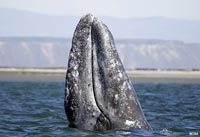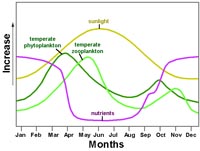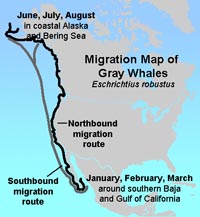16.3: Migration of Gray Whales on the West Coast
- Page ID
- 10418
Migration of Gray Whales on the West Coast
Gray whales are probably the most commonly sighted whales in the coastal waters of California. Gray whales have the longest migration of any mammal species, about 10,000 miles 16,000 km) every year. Gray Whales have a routine. They spend the winter months (December to April) in their birthing and mating grounds the shallow bays and lagoons in and around the southern Baja California and southern Gulf of California (Figure 16.23).
Gray Whales begin their northward migration in late February to May along the coastline, following the spring blooms of phytoplankton and zooplankton. They are frequently seen moving in small groups (pods) several hundred yards beyond the breaker zones to about 4 kilometers (2.5 miles [4 km]) from shore. Their destination is the rich summer feeding grounds along coastal Alaska and the Bering Sea, a distance of about 5,000-7,000 miles (8,000 to 11,000 km). Adult males and juveniles arrive in northern waters in June; females and young offspring leave and arrive a little later. They spend the summer (June to October) feasting. The first to head south are the pregnant females, followed by the others, some of whom don't make it as far south as Mexico if food resources are available farther north.
 |
 |
 |
| Figure 15.21. Gray whale | Figure 15.22. Temperate zone productivity by seasons. | Figure 16.23. Migration pattern of gray whales along the West Coast of North America. |


